child seat BMW M6 CONVERTIBLE 2013 F12 Owner's Manual
[x] Cancel search | Manufacturer: BMW, Model Year: 2013, Model line: M6 CONVERTIBLE, Model: BMW M6 CONVERTIBLE 2013 F12Pages: 222, PDF Size: 7.3 MB
Page 45 of 222
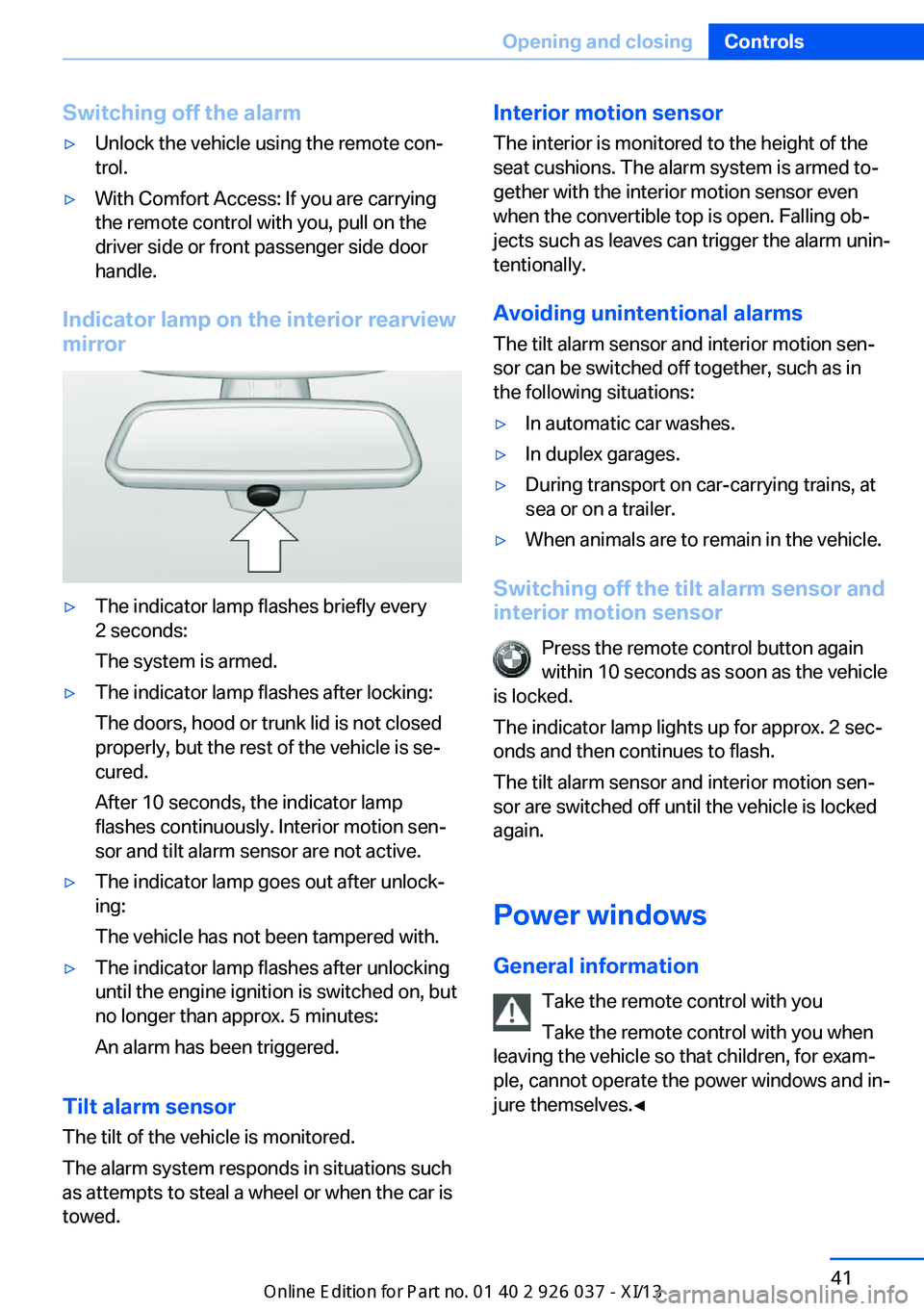
Switching off the alarm▷Unlock the vehicle using the remote con‐
trol.▷With Comfort Access: If you are carrying
the remote control with you, pull on the
driver side or front passenger side door
handle.
Indicator lamp on the interior rearview
mirror
▷The indicator lamp flashes briefly every
2 seconds:
The system is armed.▷The indicator lamp flashes after locking:
The doors, hood or trunk lid is not closed
properly, but the rest of the vehicle is se‐
cured.
After 10 seconds, the indicator lamp
flashes continuously. Interior motion sen‐
sor and tilt alarm sensor are not active.▷The indicator lamp goes out after unlock‐
ing:
The vehicle has not been tampered with.▷The indicator lamp flashes after unlocking
until the engine ignition is switched on, but
no longer than approx. 5 minutes:
An alarm has been triggered.
Tilt alarm sensor The tilt of the vehicle is monitored.
The alarm system responds in situations such
as attempts to steal a wheel or when the car is
towed.
Interior motion sensor
The interior is monitored to the height of the
seat cushions. The alarm system is armed to‐
gether with the interior motion sensor even
when the convertible top is open. Falling ob‐
jects such as leaves can trigger the alarm unin‐
tentionally.
Avoiding unintentional alarms The tilt alarm sensor and interior motion sen‐
sor can be switched off together, such as in
the following situations:▷In automatic car washes.▷In duplex garages.▷During transport on car-carrying trains, at
sea or on a trailer.▷When animals are to remain in the vehicle.
Switching off the tilt alarm sensor and
interior motion sensor
Press the remote control button again
within 10 seconds as soon as the vehicle
is locked.
The indicator lamp lights up for approx. 2 sec‐
onds and then continues to flash.
The tilt alarm sensor and interior motion sen‐
sor are switched off until the vehicle is locked
again.
Power windows
General information Take the remote control with you
Take the remote control with you when
leaving the vehicle so that children, for exam‐
ple, cannot operate the power windows and in‐
jure themselves.◀
Seite 41Opening and closingControls41
Online Edition for Part no. 01 40 2 910 746 - VI/13
Page 58 of 222

The highest level is active when three LEDs
are lit.
After a short time, the system automatically
moves down one level in order to prevent ex‐
cessive cooling.
Switching off Press the button longer.
The LEDs go out.
Safety belts
Seats with safety belt The vehicle has four seats, each of which is
equipped with a safety belt.
Hints
Always make sure that safety belts are being
worn by all occupants before driving away.
Although airbags enhance safety by providing
added protection, they are not a substitute for
safety belts.
One person per safety belt
Never allow more than one person to
wear a single safety belt. Never allow infants or
small children to ride on a passenger's lap.◀
Putting on the belt
Lay the belt, without twisting, snugly
across the lap and shoulders, as close to the
body as possible. Make sure that the belt lies
low around the hips in the lap area and does
not press on the abdomen. Otherwise, the belt
can slip over the hips in the lap area in a frontal
impact and injure the abdomen.
The safety belt must not lie across the neck,
rub on sharp edges, be routed over solid or
breakable objects, or be pinched.◀Reduction of restraining effect
Avoid wearing clothing that prevents the
belt from fitting properly, and pull the shoulder
belt periodically to readjust the tension across
your lap; otherwise, the retention effect of the
safety belt may be reduced.◀
Buckling the belt
Make sure you hear the latch plate engage in
the belt buckle.
Unbuckling the belt
1.Hold the belt firmly.2.Press the red button in the belt buckle.3.Guide the belt back into its reel.
Safety belt reminder for driver's and
passenger's seat
The indicator lamp flashes or lights up
and a signal sounds. Make sure that
the safety belts are positioned cor‐
rectly. The safety belt reminder is active at
speeds above approx. 5 mph/8 km/h. It can
also be activated if objects are placed on the
front passenger seat.
Damage to safety belts In the case of strain caused by accidents or
damage:
Have the safety belts, including the safety belt
tensioners, replaced and have the belt anchors checked.
Seite 54ControlsAdjusting54
Online Edition for Part no. 01 40 2 910 746 - VI/13
Page 65 of 222
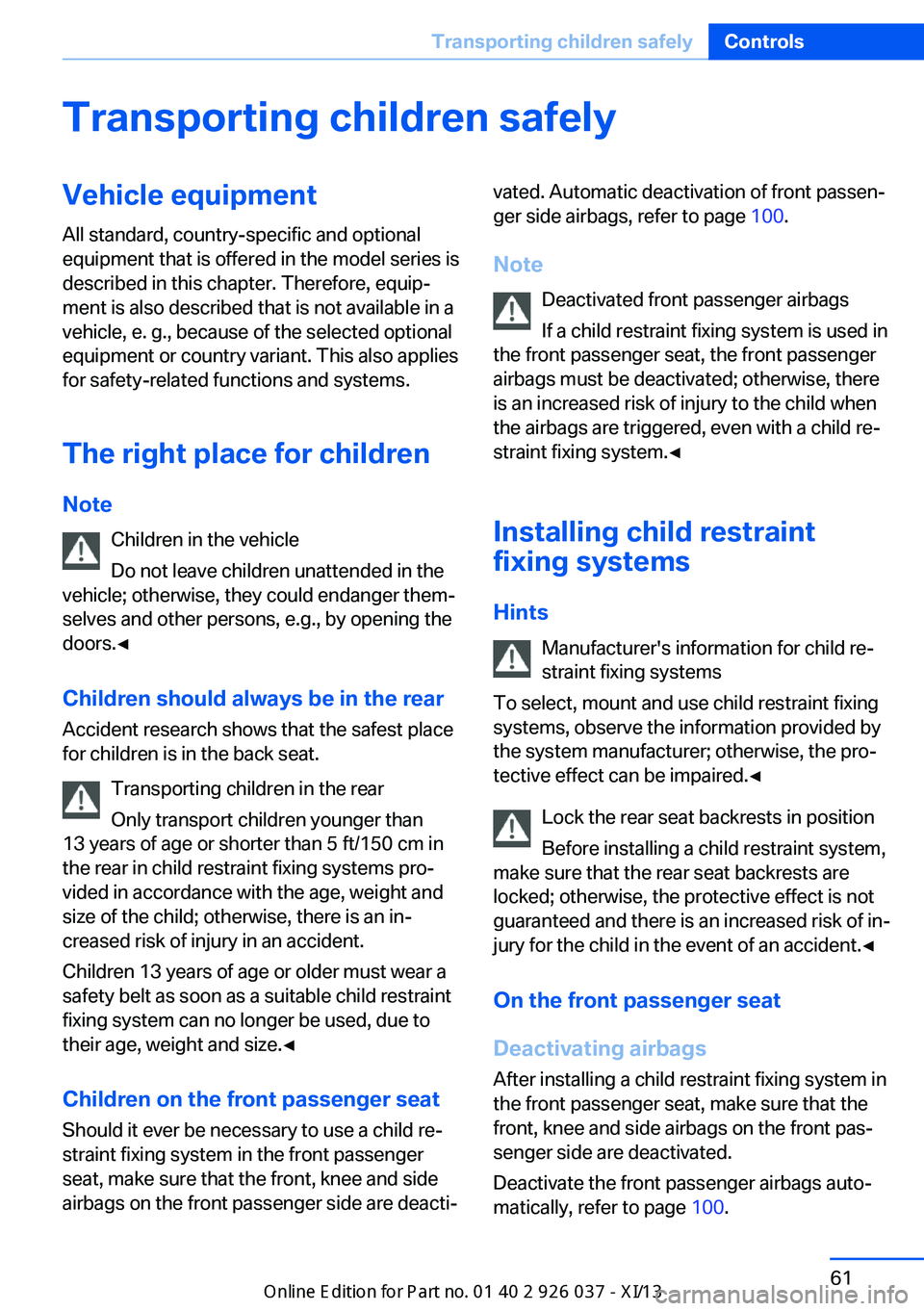
Transporting children safelyVehicle equipmentAll standard, country-specific and optional
equipment that is offered in the model series is
described in this chapter. Therefore, equip‐
ment is also described that is not available in a
vehicle, e. g., because of the selected optional
equipment or country variant. This also applies
for safety-related functions and systems.
The right place for children Note Children in the vehicle
Do not leave children unattended in the
vehicle; otherwise, they could endanger them‐
selves and other persons, e.g., by opening the
doors.◀
Children should always be in the rear
Accident research shows that the safest place
for children is in the back seat.
Transporting children in the rear
Only transport children younger than
13 years of age or shorter than 5 ft/150 cm in
the rear in child restraint fixing systems pro‐
vided in accordance with the age, weight and
size of the child; otherwise, there is an in‐
creased risk of injury in an accident.
Children 13 years of age or older must wear a
safety belt as soon as a suitable child restraint
fixing system can no longer be used, due to
their age, weight and size.◀
Children on the front passenger seat
Should it ever be necessary to use a child re‐
straint fixing system in the front passenger
seat, make sure that the front, knee and side
airbags on the front passenger side are deacti‐vated. Automatic deactivation of front passen‐
ger side airbags, refer to page 100.
Note Deactivated front passenger airbags
If a child restraint fixing system is used in
the front passenger seat, the front passenger
airbags must be deactivated; otherwise, there
is an increased risk of injury to the child when
the airbags are triggered, even with a child re‐
straint fixing system.◀
Installing child restraint
fixing systems
Hints Manufacturer's information for child re‐
straint fixing systems
To select, mount and use child restraint fixing
systems, observe the information provided by
the system manufacturer; otherwise, the pro‐
tective effect can be impaired.◀
Lock the rear seat backrests in position
Before installing a child restraint system,
make sure that the rear seat backrests are
locked; otherwise, the protective effect is not
guaranteed and there is an increased risk of in‐
jury for the child in the event of an accident.◀
On the front passenger seat
Deactivating airbags
After installing a child restraint fixing system in
the front passenger seat, make sure that the
front, knee and side airbags on the front pas‐
senger side are deactivated.
Deactivate the front passenger airbags auto‐
matically, refer to page 100.Seite 61Transporting children safelyControls61
Online Edition for Part no. 01 40 2 910 746 - VI/13
Page 66 of 222
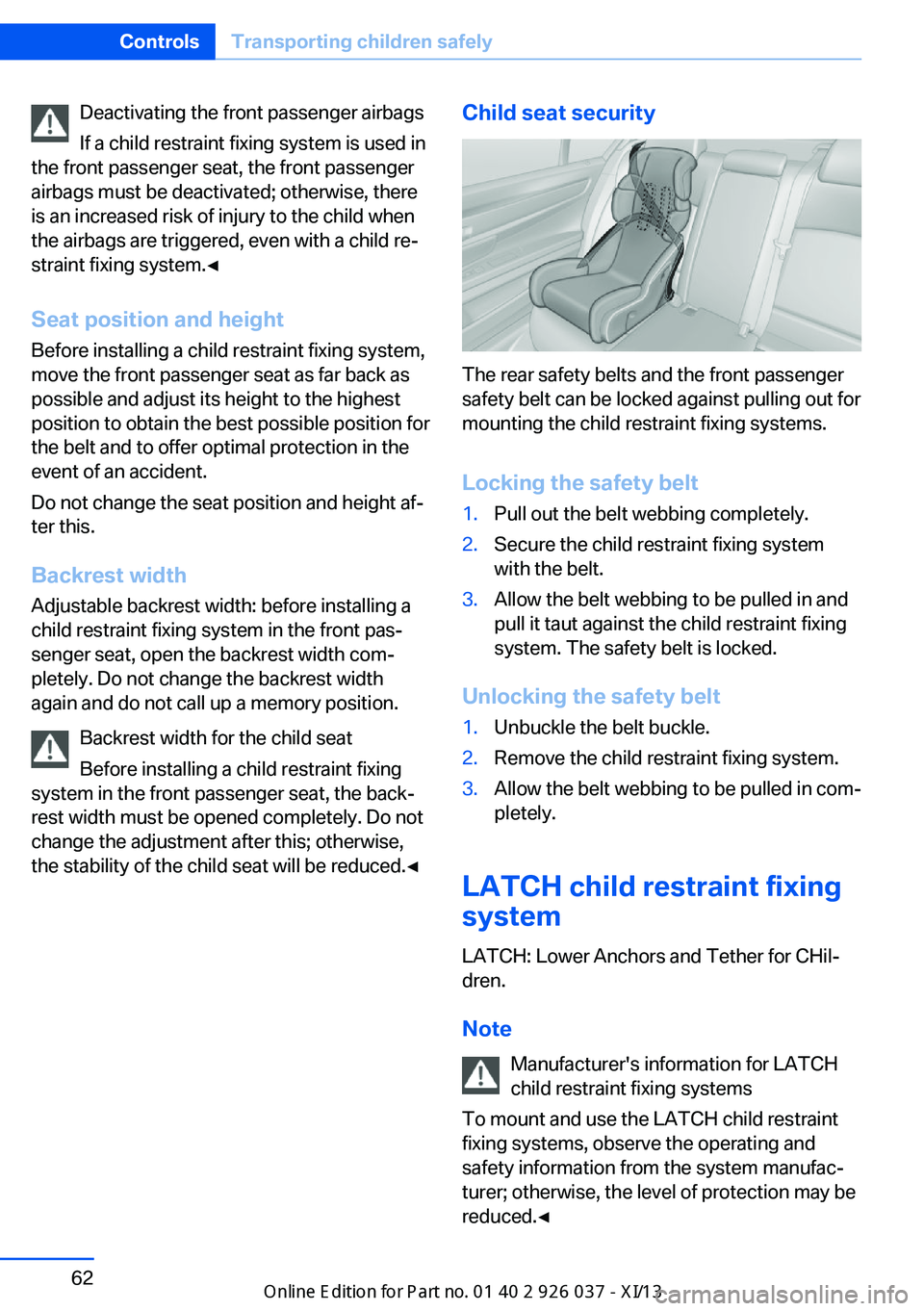
Deactivating the front passenger airbags
If a child restraint fixing system is used in
the front passenger seat, the front passenger
airbags must be deactivated; otherwise, there
is an increased risk of injury to the child when
the airbags are triggered, even with a child re‐
straint fixing system.◀
Seat position and height
Before installing a child restraint fixing system,
move the front passenger seat as far back as
possible and adjust its height to the highest
position to obtain the best possible position for
the belt and to offer optimal protection in the
event of an accident.
Do not change the seat position and height af‐
ter this.
Backrest width Adjustable backrest width: before installing a
child restraint fixing system in the front pas‐
senger seat, open the backrest width com‐
pletely. Do not change the backrest width
again and do not call up a memory position.
Backrest width for the child seat
Before installing a child restraint fixing
system in the front passenger seat, the back‐
rest width must be opened completely. Do not
change the adjustment after this; otherwise,
the stability of the child seat will be reduced.◀Child seat security
The rear safety belts and the front passenger
safety belt can be locked against pulling out for
mounting the child restraint fixing systems.
Locking the safety belt
1.Pull out the belt webbing completely.2.Secure the child restraint fixing system
with the belt.3.Allow the belt webbing to be pulled in and
pull it taut against the child restraint fixing
system. The safety belt is locked.
Unlocking the safety belt
1.Unbuckle the belt buckle.2.Remove the child restraint fixing system.3.Allow the belt webbing to be pulled in com‐
pletely.
LATCH child restraint fixing
system
LATCH: Lower Anchors and Tether for CHil‐dren.
Note Manufacturer's information for LATCH
child restraint fixing systems
To mount and use the LATCH child restraint
fixing systems, observe the operating and
safety information from the system manufac‐
turer; otherwise, the level of protection may be
reduced.◀
Seite 62ControlsTransporting children safely62
Online Edition for Part no. 01 40 2 910 746 - VI/13
Page 67 of 222

Mounts for the lower LATCH anchorsThe lower anchors may be used to attach the
CRS to the vehicle seat up to a combined child
and CRS weight of 65 lb/30 kg when the child
is restr- ained by the internal harnesses.
Correctly engage the lower LATCH an‐
chors
Make sure that the lower LATCH anchors have
properly engaged and that the child restraint
fixing system is resting snugly against the
backrest; otherwise, the degree of protection
offered may be reduced.◀
Before mounting the LATCH child restraint fix‐
ing system, pull the belt away from the child
restraint fixing system.
Mounts for the lower LATCH anchors are lo‐
cated in the gap between the seat and back‐
rest.
Mounting ISOFIX child restraint fixing systems
1.Mount the child restraint fixing system; re‐
fer to the user's manual of the system.2.Ensure that both LATCH anchors are prop‐
erly connected.
Child restraint fixing system with a
tether strap
For Canadian customers Only The following statement is required by Trans‐port Canada:
This vehicle is not equipped with user-ready
tether anchorages. As such neither a child re‐
straint system, nor a booster cushion, requirer‐
ing the use of a tether strap can be properly
secured in the vehicle.Seite 63Transporting children safelyControls63
Online Edition for Part no. 01 40 2 910 746 - VI/13
Page 70 of 222

Engine stop
Hints Take the remote control with youTake the remote control with you when
leaving the vehicle so that children, for exam‐
ple, cannot start the engine.◀
Set the parking brake and further secure
the vehicle as required
Set the parking brake firmly when parking; oth‐
erwise, the vehicle could roll. On steep upward
and downward inclines, further secure the ve‐
hicle, for example, by turning the steering
wheel in the direction of the curb. ◀
Before driving into a car wash
In order for the vehicle to be able to roll into a
car wash, heed the information regarding
Washing in automatic car washes, refer to
page 196.
Manual transmission
Switching off the engine1.With the vehicle at a standstill, press the
Start/Stop button.2.Shift into first gear or reverse.3.Set the parking brake.
Double-clutch transmission
Switching off the engine
1.Apply the brakes until the vehicle comes to
a stop.2.Press the Start/Stop button.
The engine is switched off.
The radio ready state is switched on.3.Set the parking brake.Automatic Engine Start/Stop
Function
The concept The Auto Start/Stop function helps save fuel.
The system switches off the engine during a
stop, e.g., in a traffic congestion or at traffic
lights. The ignition remains switched on. The
engine starts again automatically for driving
off.
Certain vehicle components may experience
additional wear as a result of this system.
Semi-automatic mode
After every start of the engine, the Auto Start
Stop function is in the last selected state, refer
to page 68. When the Auto Start Stop func‐
tion is active, it is available when the vehicle is
traveling faster than about 3 mph, approx.
5 km/h.
Engine stop
The engine is switched off automatically dur‐
ing a stop under the following conditions:
Double-clutch transmission:▷The selector lever is in transmission posi‐
tion D.▷Brake pedal remains depressed while the
vehicle is stopped.▷The driver's seat belt is buckled or the driv‐
er's door is closed.
The air volume of the air conditioner is reduced
when the engine is switched off.
Displays in the instrument cluster The display indicates that the
automatic engine start-stop
function is ready for an auto‐
matic engine start.
Seite 66ControlsDriving66
Online Edition for Part no. 01 40 2 910 746 - VI/13
Page 104 of 222
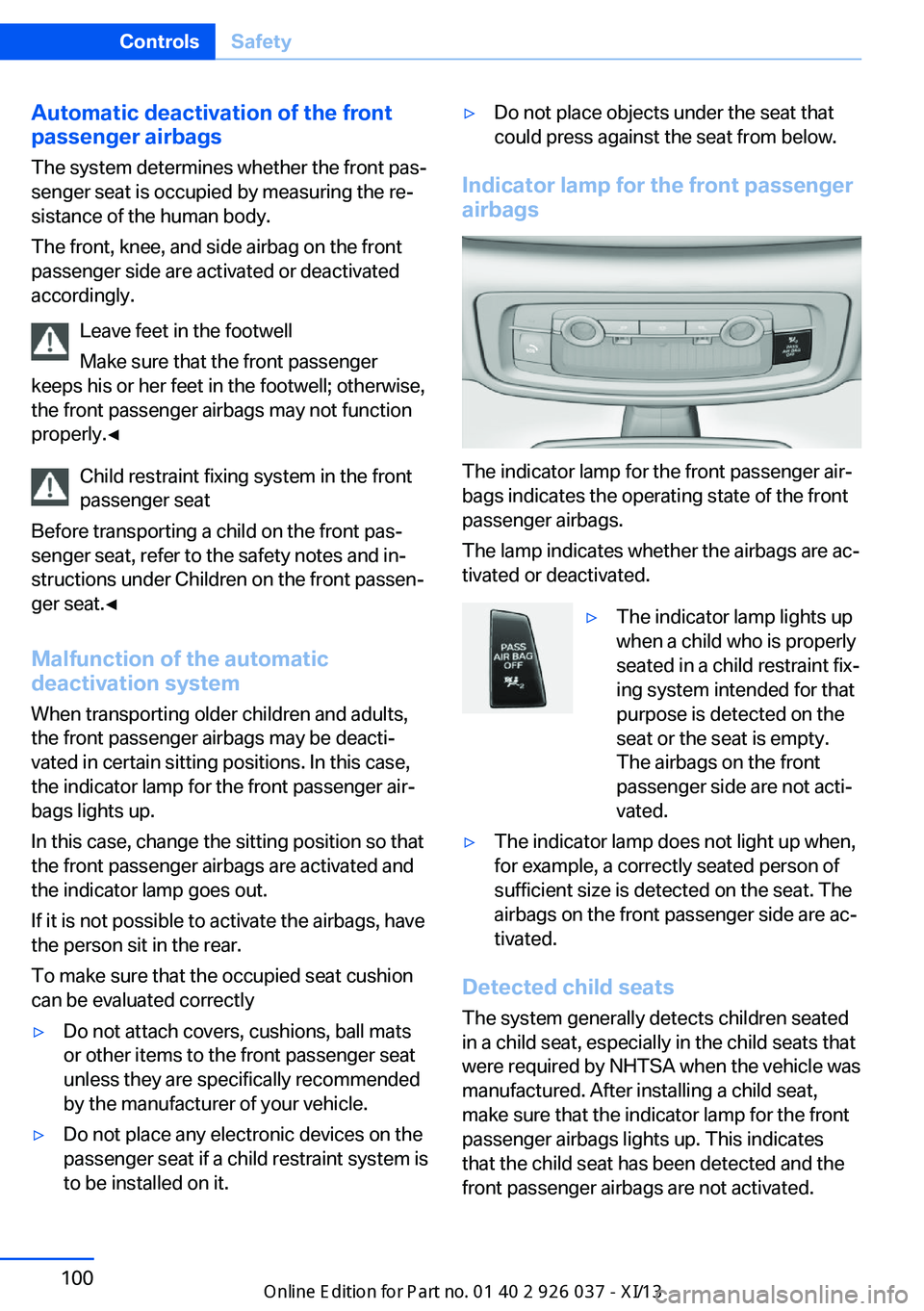
Automatic deactivation of the frontpassenger airbags
The system determines whether the front pas‐
senger seat is occupied by measuring the re‐
sistance of the human body.
The front, knee, and side airbag on the front
passenger side are activated or deactivated
accordingly.
Leave feet in the footwell
Make sure that the front passenger
keeps his or her feet in the footwell; otherwise,
the front passenger airbags may not function
properly.◀
Child restraint fixing system in the front
passenger seat
Before transporting a child on the front pas‐
senger seat, refer to the safety notes and in‐
structions under Children on the front passen‐
ger seat.◀
Malfunction of the automatic
deactivation system
When transporting older children and adults,
the front passenger airbags may be deacti‐
vated in certain sitting positions. In this case,
the indicator lamp for the front passenger air‐
bags lights up.
In this case, change the sitting position so that
the front passenger airbags are activated and
the indicator lamp goes out.
If it is not possible to activate the airbags, have
the person sit in the rear.
To make sure that the occupied seat cushion
can be evaluated correctly▷Do not attach covers, cushions, ball mats
or other items to the front passenger seat
unless they are specifically recommended
by the manufacturer of your vehicle.▷Do not place any electronic devices on the
passenger seat if a child restraint system is
to be installed on it.▷Do not place objects under the seat that
could press against the seat from below.
Indicator lamp for the front passenger
airbags
The indicator lamp for the front passenger air‐
bags indicates the operating state of the front
passenger airbags.
The lamp indicates whether the airbags are ac‐
tivated or deactivated.
▷The indicator lamp lights up
when a child who is properly
seated in a child restraint fix‐
ing system intended for that
purpose is detected on the
seat or the seat is empty.
The airbags on the front
passenger side are not acti‐
vated.▷The indicator lamp does not light up when,
for example, a correctly seated person of
sufficient size is detected on the seat. The
airbags on the front passenger side are ac‐
tivated.
Detected child seats
The system generally detects children seated
in a child seat, especially in the child seats that
were required by NHTSA when the vehicle was
manufactured. After installing a child seat,
make sure that the indicator lamp for the front
passenger airbags lights up. This indicates that the child seat has been detected and the
front passenger airbags are not activated.
Seite 100ControlsSafety100
Online Edition for Part no. 01 40 2 910 746 - VI/13
Page 213 of 222

Braking, hints 156
Breakdown assis‐ tance 190, 191
Breaking in 154
Brightness of Control Dis‐ play 92
Bulb replacement, front 184
Bulb replacement, rear 186
Button, Start/Stop 64
Bypassing, refer to Jump- starting 192
C
California Proposition 65 Warning 7
Calling up mirror adjust‐ ment 40
Calling up seat adjust‐ ment 40
Calling up steering wheel ad‐ justment 40
Camera, backup camera 128
Camera, care 200
Camera, Side View 132
Camera, Top View 131
Can holder, refer to Cu‐ pholder 148
Car battery 188
Carbon ceramic brake M 152
Car care products 197
Care, displays 200
Care, vehicle 197
Cargo 158
Cargo area lid 37
Cargo area partition 45
Cargo area, storage compart‐ ments 148
Cargo, securing 159
Cargo straps, securing cargo 159
Car key, refer to Remote con‐ trol 30
Carpet, care 199
Car wash 196 Catalytic converter, refer to
Hot exhaust system 155
CBS Condition Based Serv‐ ice 182
CD/Multimedia, see user's manual for Navigation, En‐
tertainment and Communi‐
cation
Center console 14
Center-Lock, see button for central locking 33
Central locking system 33
Central screen, refer to Con‐ trol Display 16
Ceramic brake 152
Changes, technical, refer to Safety 7
Changing parts 184
Changing wheels 187
Changing wheels/tires 171
Check Control 80
Checking the oil level elec‐ tronically 178
Children, seating position 61
Children, transporting safely 61
Child restraint fixing sys‐ tem 61
Child restraint fixing system LATCH 62
Child restraint fixing systems, mounting 61
Child seat, mounting 61
Child seats 61
Chrome parts, care 199
Cigarette lighter 143
Cleaning, displays 200
Climate control 136
Climate control wind‐ shield 155
Clock 83
Closing/opening from in‐ side 36
Closing/opening via door lock 36 Closing/opening with remote
control 34
Collision warning with City Braking function 106
Combination switch, refer to Turn signals 75
Combination switch, refer to Wiper system 76
Comfort Access 38
Compound brake 152
Compressor 172
Computer 89
Condensation on win‐ dows 138
Condensation under the vehi‐ cle 157
Condition Based Service CBS 182
Confirmation signal 39
ConnectedDrive, see user's manual for Navigation, En‐
tertainment and Communi‐
cation
ConnectedDrive Services
Control Display 16
Control Display, settings 91
Controller 16
Control systems, driving sta‐ bility 119
Convenient closing 34
Convenient opening 34
Convertible, convertible top 43
Convertible mode, automatic climate control 137
Convertible program, auto‐ matic climate control 137
Convertible top 43
Convertible top, care 198
Convertible top, cargo area partition 45
Convertible top, emergency operation 46
Convertible top, rollover pro‐ tection system 101
Convertible top tool 46 Seite 209Everything from A to ZReference209
Online Edition for Part no. 01 40 2 910 746 - VI/13
Page 217 of 222
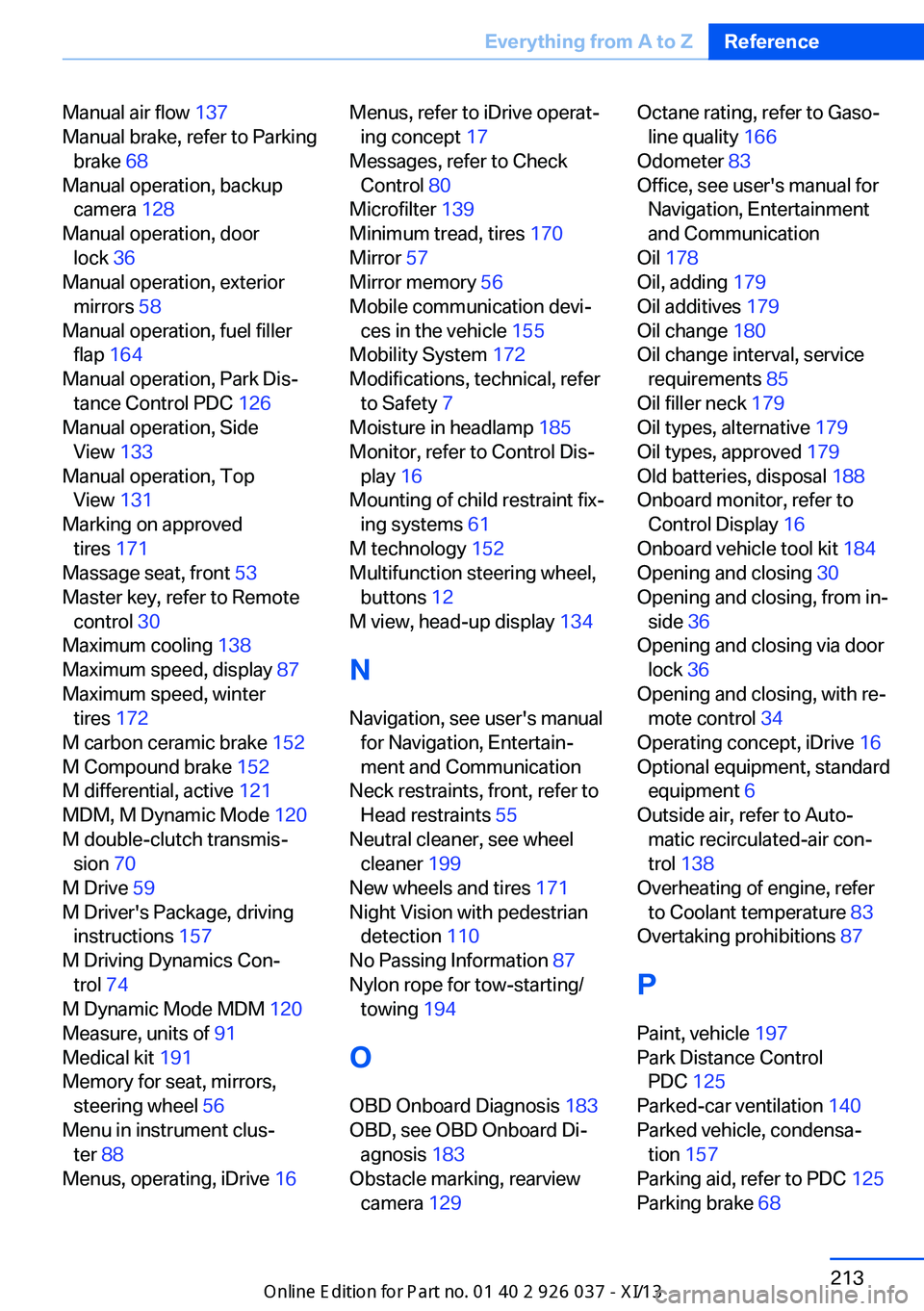
Manual air flow 137
Manual brake, refer to Parking brake 68
Manual operation, backup camera 128
Manual operation, door lock 36
Manual operation, exterior mirrors 58
Manual operation, fuel filler flap 164
Manual operation, Park Dis‐ tance Control PDC 126
Manual operation, Side View 133
Manual operation, Top View 131
Marking on approved tires 171
Massage seat, front 53
Master key, refer to Remote control 30
Maximum cooling 138
Maximum speed, display 87
Maximum speed, winter tires 172
M carbon ceramic brake 152
M Compound brake 152
M differential, active 121
MDM, M Dynamic Mode 120
M double-clutch transmis‐ sion 70
M Drive 59
M Driver's Package, driving instructions 157
M Driving Dynamics Con‐ trol 74
M Dynamic Mode MDM 120
Measure, units of 91
Medical kit 191
Memory for seat, mirrors, steering wheel 56
Menu in instrument clus‐ ter 88
Menus, operating, iDrive 16 Menus, refer to iDrive operat‐
ing concept 17
Messages, refer to Check Control 80
Microfilter 139
Minimum tread, tires 170
Mirror 57
Mirror memory 56
Mobile communication devi‐ ces in the vehicle 155
Mobility System 172
Modifications, technical, refer to Safety 7
Moisture in headlamp 185
Monitor, refer to Control Dis‐ play 16
Mounting of child restraint fix‐ ing systems 61
M technology 152
Multifunction steering wheel, buttons 12
M view, head-up display 134
N
Navigation, see user's manual for Navigation, Entertain‐
ment and Communication
Neck restraints, front, refer to Head restraints 55
Neutral cleaner, see wheel cleaner 199
New wheels and tires 171
Night Vision with pedestrian detection 110
No Passing Information 87
Nylon rope for tow-starting/ towing 194
O OBD Onboard Diagnosis 183
OBD, see OBD Onboard Di‐ agnosis 183
Obstacle marking, rearview camera 129 Octane rating, refer to Gaso‐
line quality 166
Odometer 83
Office, see user's manual for Navigation, Entertainment
and Communication
Oil 178
Oil, adding 179
Oil additives 179
Oil change 180
Oil change interval, service requirements 85
Oil filler neck 179
Oil types, alternative 179
Oil types, approved 179
Old batteries, disposal 188
Onboard monitor, refer to Control Display 16
Onboard vehicle tool kit 184
Opening and closing 30
Opening and closing, from in‐ side 36
Opening and closing via door lock 36
Opening and closing, with re‐ mote control 34
Operating concept, iDrive 16
Optional equipment, standard equipment 6
Outside air, refer to Auto‐ matic recirculated-air con‐
trol 138
Overheating of engine, refer to Coolant temperature 83
Overtaking prohibitions 87
P Paint, vehicle 197
Park Distance Control PDC 125
Parked-car ventilation 140
Parked vehicle, condensa‐ tion 157
Parking aid, refer to PDC 125
Parking brake 68 Seite 213Everything from A to ZReference213
Online Edition for Part no. 01 40 2 910 746 - VI/13
Page 219 of 222
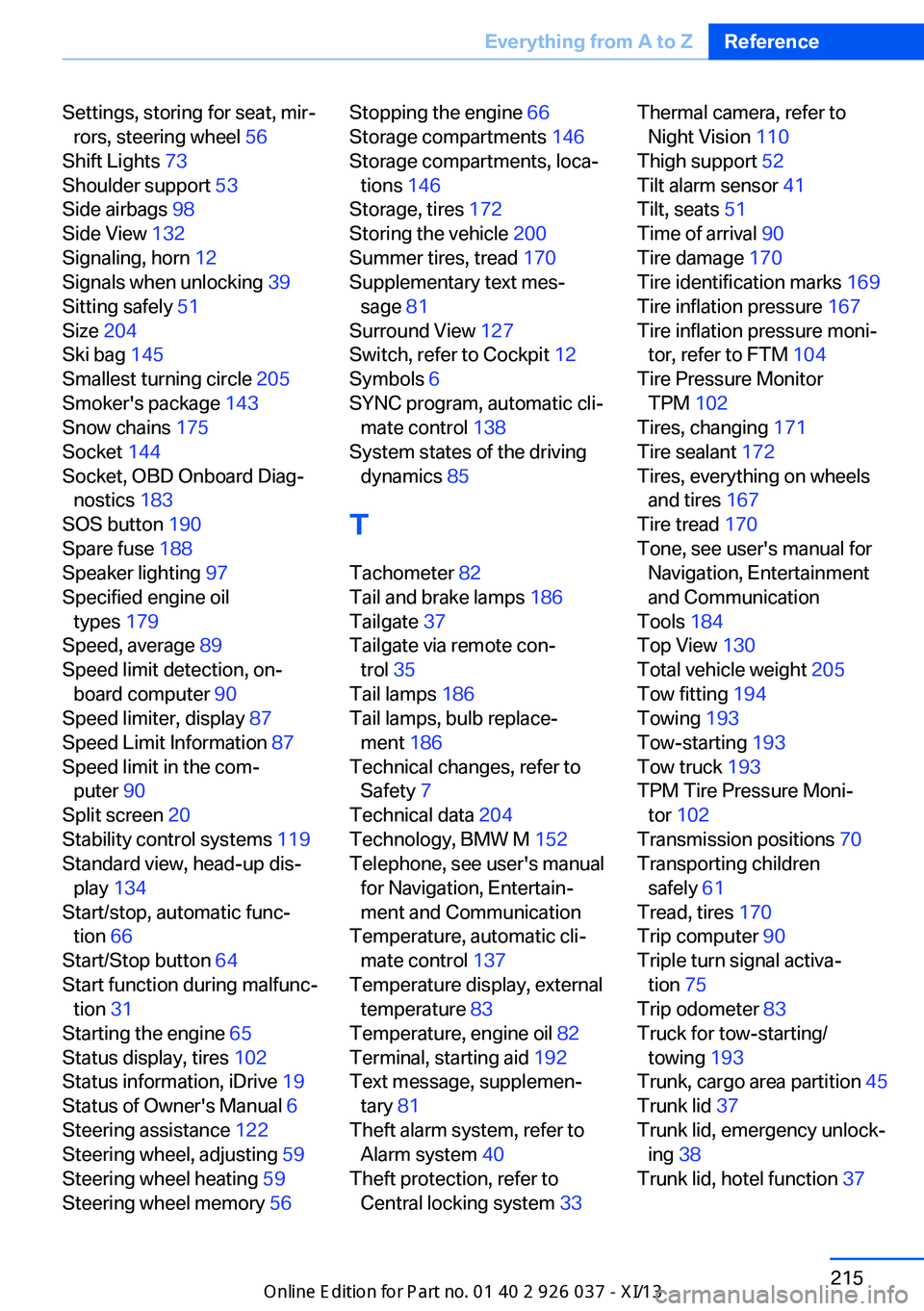
Settings, storing for seat, mir‐rors, steering wheel 56
Shift Lights 73
Shoulder support 53
Side airbags 98
Side View 132
Signaling, horn 12
Signals when unlocking 39
Sitting safely 51
Size 204
Ski bag 145
Smallest turning circle 205
Smoker's package 143
Snow chains 175
Socket 144
Socket, OBD Onboard Diag‐ nostics 183
SOS button 190
Spare fuse 188
Speaker lighting 97
Specified engine oil types 179
Speed, average 89
Speed limit detection, on‐ board computer 90
Speed limiter, display 87
Speed Limit Information 87
Speed limit in the com‐ puter 90
Split screen 20
Stability control systems 119
Standard view, head-up dis‐ play 134
Start/stop, automatic func‐ tion 66
Start/Stop button 64
Start function during malfunc‐ tion 31
Starting the engine 65
Status display, tires 102
Status information, iDrive 19
Status of Owner's Manual 6
Steering assistance 122
Steering wheel, adjusting 59
Steering wheel heating 59
Steering wheel memory 56 Stopping the engine 66
Storage compartments 146
Storage compartments, loca‐ tions 146
Storage, tires 172
Storing the vehicle 200
Summer tires, tread 170
Supplementary text mes‐ sage 81
Surround View 127
Switch, refer to Cockpit 12
Symbols 6
SYNC program, automatic cli‐ mate control 138
System states of the driving dynamics 85
T
Tachometer 82
Tail and brake lamps 186
Tailgate 37
Tailgate via remote con‐ trol 35
Tail lamps 186
Tail lamps, bulb replace‐ ment 186
Technical changes, refer to Safety 7
Technical data 204
Technology, BMW M 152
Telephone, see user's manual for Navigation, Entertain‐
ment and Communication
Temperature, automatic cli‐ mate control 137
Temperature display, external temperature 83
Temperature, engine oil 82
Terminal, starting aid 192
Text message, supplemen‐ tary 81
Theft alarm system, refer to Alarm system 40
Theft protection, refer to Central locking system 33 Thermal camera, refer to
Night Vision 110
Thigh support 52
Tilt alarm sensor 41
Tilt, seats 51
Time of arrival 90
Tire damage 170
Tire identification marks 169
Tire inflation pressure 167
Tire inflation pressure moni‐ tor, refer to FTM 104
Tire Pressure Monitor TPM 102
Tires, changing 171
Tire sealant 172
Tires, everything on wheels and tires 167
Tire tread 170
Tone, see user's manual for Navigation, Entertainment
and Communication
Tools 184
Top View 130
Total vehicle weight 205
Tow fitting 194
Towing 193
Tow-starting 193
Tow truck 193
TPM Tire Pressure Moni‐ tor 102
Transmission positions 70
Transporting children safely 61
Tread, tires 170
Trip computer 90
Triple turn signal activa‐ tion 75
Trip odometer 83
Truck for tow-starting/ towing 193
Trunk, cargo area partition 45
Trunk lid 37
Trunk lid, emergency unlock‐ ing 38
Trunk lid, hotel function 37 Seite 215Everything from A to ZReference215
Online Edition for Part no. 01 40 2 910 746 - VI/13